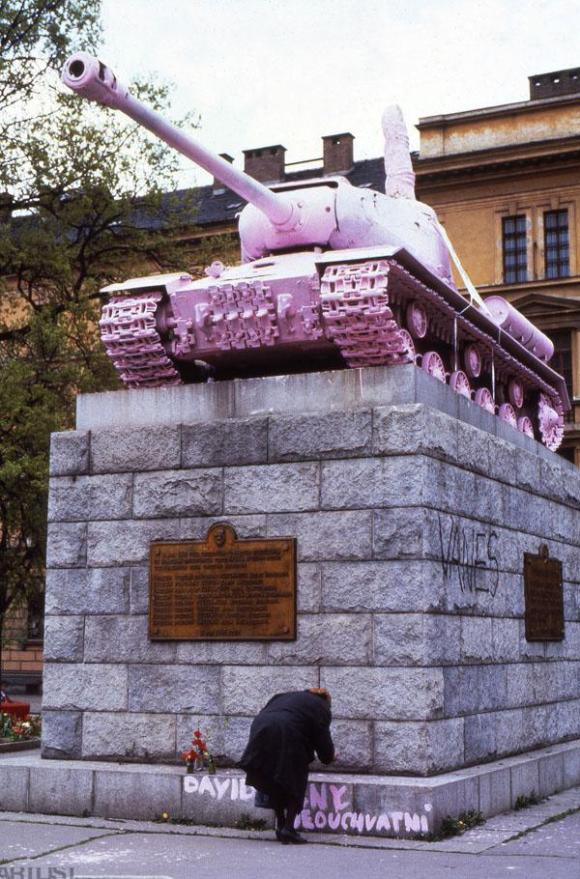
There is a common conception that destroying monuments erases history. This is supposed to be bad for one of two reasons: either the big chunk of stone in question is the sacred reminder of a treasured past–a relic–or it gives a lesson, even a warning, from history–a museum piece. Either way, the object deserves our gratitude because of its capacity to admonish us: the elderly slab should be preserved to wag its finger at every new viewer from now til eternity.
But all these meanings happen to already be packed into the original Latin sense of monumentum, and provide equal justification for them to be destroyed by mobs. Etymology is often bullshit because words’ meanings are path-dependent: they shift for chaotic cultural and historical reasons. The Germanic root for “hound” meant “dog, in general” and the root for “dog” meant “a specific powerful breed of dog.” Their reversal doesn’t tell us much about the very being of dogs. But “monuments” are different. Latin monumentum was literally “something that reminds” -> “a tomb, votive offering, memorial record” from monēre “to admonish, warn, advise.”
Why do we set up carved rocks at great expense to “admonish, warn, and advise” us? The brilliant French crackpot theorist George Bataille nailed the politics of monuments–what really makes them monumental–in a justly famous three-paragraph article from 1929:
“Architecture expresses the very being of societies, in the same way that human physiognomy is the expression of the being of individuals. But it is really the being of bureaucrats and officials that architecture expresses. In practice, only the ideal being of society, the one that orders and prohibits, expresses itself in architecture in the strict sense. Thus, the great monuments are raised up like dams, pitting the logic of majesty and authority against all troublemakers: it is in the form of cathedrals and palaces that Church and State speak and impose silence on the multitudes. In fact it is clear that monuments inspire socially acceptable behavior and often very real fear. The storming of the Bastille is symbolic of this state of affairs: it is difficult to explain this impulse of the mob other than by the animosity the people hold against the monuments which are their true masters.”
What makes certain public buildings and slabs of stone monumental is the power they have to order, intimidate, and scold the viewer to behave. And after enough of this, people sometimes want revenge: why else would the peasants and revolutionaries attack the Bastille itself?
Not all tall buildings or tombstones are monuments. You need to separate a thing’s monumentality–what it means politically–from its bare physical shape, because plenty of big objects don’t really play much of a monumental role. As the Chinese art historian Wu Hung writes, monumentality is “an integral element that lends a building, statue, or any large-scale thing a common, commemorative meaning.” Monuments are things that play a particular role in people’s memories. Wu points out that already in his 1903 “The Modern Worship of Monuments: Its Nature and Origins” the art historian Alois Riegl broadened the notion of “monument” to things that later acquired commemorative value, such as written documents like the Declaration of Independence. Indeed, he notes, the request after the Civil War to make the farmland and roads that made up the entire Gettysburg battlefield a national monument suggests that a monument can be of any form.
Monumentality, then, is a kind of social contract, but not one we’re allowed to freely enter into. An object gets its monumentality from a shared political relationship with a group of people, but this shared relationship may be as much one of intimidation as consent. What happens when one group of people insist that a heroic statue of a white man is a collective monument of their whole society, and commemorates a shared past, while another group doesn’t agree that this man is their hero, a chosen emblem of their past, that history did not happen like this or mean what the others say it meant? What if in that past the other group were defined as servile or as objects?
In the picture at the top, a Soviet tank was painted pink and had a gigantic–even monumental–dildo stuck on. An object can be changed from a monument to one thing to an anti-monument, or a monument to something else. But if the monument gives only one verdict, attempting to pass the same judgement on its viewers for all time, the only healthy response may be to tear it down.
*This piece was inspired by my work with the UCLA Near Eastern Studies graduate student Timothy Hogue, whose research led me to these ideas and which will result in a totally fresh view of the Ten Commandments as a cultural monument but who is definitely not responsible for the views here.